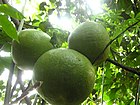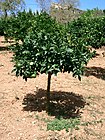Note: This is a project under development. The articles on this wiki are just being initiated and broadly incomplete. You can Help creating new pages.
Difference between revisions of "Citrus maxima - Mallikapuspa"
(→Commonly seen growing in areas) |
|||
| (15 intermediate revisions by 2 users not shown) | |||
| Line 3: | Line 3: | ||
==Uses== | ==Uses== | ||
| − | {{Uses| | + | {{Uses|Ulcers}}, {{Uses|Cough}}, {{Uses|Dyspepsia}}, {{Uses|Painful swellings}}, {{Uses|Diabetes}}, {{Uses|Malaria}}, {{Uses|Urinary flow}}, {{Uses|Diarrhea}}, {{Uses|Sore throats}} |
==Parts Used== | ==Parts Used== | ||
| − | {{Parts Used|Leaves}}, {{Parts Used| | + | {{Parts Used|Leaves}}, {{Parts Used|Flowers}}, {{Parts Used|Fruits}}, {{Parts Used|Rind}} |
==Chemical Composition== | ==Chemical Composition== | ||
| − | + | The root-bark contains beta-sitosterol and acridone alkaloids. It also contains several coumarins. The alkaloids and coumarins show antimicrobial acitivity. The essential oil from the leaves and unripe fruits contain 20% limonin, 30% nerolol, 40% nerolyl acetate and 3% geraniol.<ref name="chemical composition"/> | |
==Common names== | ==Common names== | ||
| − | {{Common names|kn=|ml=|sa=|ta=|te=|hi=|en= | + | {{Common names|kn=ಚಕೋತ ಹಣ್ಣು Cakota hannu|ml=Kampilinaranna|sa=Karuna|gu=Papanas|ta=Metukku|pa=Chakotra|te=Pamparapanasa|hi=Batawi-nimbu|en=Chinese grapefruit, Pomelo, Pompelmous|mr=Bampara}}<ref name="Common names"/> |
==Properties== | ==Properties== | ||
| Line 31: | Line 31: | ||
==Habit== | ==Habit== | ||
| − | {{Habit|Evergreen | + | {{Habit|Evergreen tree}} |
==Identification== | ==Identification== | ||
| Line 46: | Line 46: | ||
==List of Ayurvedic medicine in which the herb is used== | ==List of Ayurvedic medicine in which the herb is used== | ||
| − | |||
==Where to get the saplings== | ==Where to get the saplings== | ||
| Line 56: | Line 55: | ||
==Commonly seen growing in areas== | ==Commonly seen growing in areas== | ||
| − | {{Commonly seen| | + | {{Commonly seen|Tropical area}}, {{Commonly seen|Subtropical area}}, {{Commonly seen|Temperate region}}. |
==Photo Gallery== | ==Photo Gallery== | ||
<gallery class="left" caption="" widths="140px" heights="140px"> | <gallery class="left" caption="" widths="140px" heights="140px"> | ||
| − | + | 171 - CIMG2721.JPG | |
| − | + | Babloos Naranga IMG 4329.JPG | |
| − | + | Citrus maxima (Pampelmuse) 002.jpg | |
| + | Citrus maxima (Pampelmuse) 003.jpg | ||
| + | Aranger Citrus maxima.jpg | ||
</gallery> | </gallery> | ||
| Line 68: | Line 69: | ||
<references> | <references> | ||
| − | <ref name="chemical composition">[ | + | <ref name="chemical composition">[http://gbpihedenvis.nic.in/PDFs/Glossary_Medicinal_Plants_Springer.pdf "chemical constituents"]</ref> |
<ref name="Leaf">[http://eol.org/pages/488254/details "morphology"]</ref> | <ref name="Leaf">[http://eol.org/pages/488254/details "morphology"]</ref> | ||
| + | <ref name="Common names">[https://sites.google.com/site/indiannamesofplants/via-species/c/citrus-maxima Common names]</ref> | ||
<ref name="How to plant/cultivate">[http://tropical.theferns.info/viewtropical.php?id=Citrus+maxima "Cultivation Details"]</ref> | <ref name="How to plant/cultivate">[http://tropical.theferns.info/viewtropical.php?id=Citrus+maxima "Cultivation Details"]</ref> | ||
| Line 82: | Line 84: | ||
[[Category:Herbs]] | [[Category:Herbs]] | ||
| + | [[Category:Ayurvedic herbs that don't have seed photos]] | ||
| + | [[Category:Rutaceae]] | ||
Latest revision as of 15:20, 22 June 2020
Citrus maxima is a citrus fruit with the appearance of a big grapefruit and it is native to South and Southeast Asia.
Uses
Ulcers, Cough, Dyspepsia, Painful swellings, Diabetes, Malaria, Urinary flow, Diarrhea, Sore throats
Parts Used
Chemical Composition
The root-bark contains beta-sitosterol and acridone alkaloids. It also contains several coumarins. The alkaloids and coumarins show antimicrobial acitivity. The essential oil from the leaves and unripe fruits contain 20% limonin, 30% nerolol, 40% nerolyl acetate and 3% geraniol.[1]
Common names
| Language | Common name |
|---|---|
| Kannada | ಚಕೋತ ಹಣ್ಣು Cakota hannu |
| Hindi | Batawi-nimbu |
| Malayalam | Kampilinaranna |
| Tamil | Metukku |
| Telugu | Pamparapanasa |
| Marathi | Bampara |
| Gujarathi | Papanas |
| Punjabi | Chakotra |
| Kashmiri | NA |
| Sanskrit | Karuna |
| English | Chinese grapefruit, Pomelo, Pompelmous |
Properties
Reference: Dravya - Substance, Rasa - Taste, Guna - Qualities, Veerya - Potency, Vipaka - Post-digesion effect, Karma - Pharmacological activity, Prabhava - Therepeutics.
Dravya
Rasa
Amla (sour), Madhura (Sweet)
Guna
Laghu (Light), Snigda (heavy)
Veerya
Ushna (Hot)
Vipaka
Amla (sour)
Karma
Vata, Kapha
Prabhava
Habit
Identification
Leaf
| Kind | Shape | Feature |
|---|---|---|
| Simple | ovate-elliptic | Sparsely pubescent to glabrous on the lower surface |
Flower
| Type | Size | Color and composition | Stamen | More information |
|---|---|---|---|---|
| Unisexual | 2-4cm long | Yellow | 16-24 | Flowers large, pedicel pubescent |
Fruit
| Type | Size | Mass | Appearance | Seeds | More information |
|---|---|---|---|---|---|
| globose | 13-17 cm | Pulp yellow or pink-crimson, pulp vesicles lax, acid or slightly bitter | With hooked hairs | Seeds ridged | {{{6}}} |
Other features
List of Ayurvedic medicine in which the herb is used
Where to get the saplings
Mode of Propagation
How to plant/cultivate
Three main climates are suitable for commercial citrus production - tropical climates[4]
Commonly seen growing in areas
Photo Gallery
References
External Links
- Ayurvedic Herbs known to be helpful to treat Ulcers
- Ayurvedic Herbs known to be helpful to treat Cough
- Ayurvedic Herbs known to be helpful to treat Dyspepsia
- Ayurvedic Herbs known to be helpful to treat Painful swellings
- Ayurvedic Herbs known to be helpful to treat Diabetes
- Ayurvedic Herbs known to be helpful to treat Malaria
- Ayurvedic Herbs known to be helpful to treat Urinary flow
- Ayurvedic Herbs known to be helpful to treat Diarrhea
- Ayurvedic Herbs known to be helpful to treat Sore throats
- Herbs with Leaves used in medicine
- Herbs with Flowers used in medicine
- Herbs with Fruits used in medicine
- Herbs with Rind used in medicine
- Herbs with common name in Kannada
- Herbs with common name in Hindi
- Herbs with common name in Malayalam
- Herbs with common name in Tamil
- Herbs with common name in Telugu
- Herbs with common name in Marathi
- Herbs with common name in Gujarathi
- Herbs with common name in Punjabi
- Herbs with common name in Sanskrit
- Herbs with common name in English
- Habit - Evergreen tree
- Index of Plants which can be propagated by Seeds
- Index of Plants which can be propagated by Cuttings
- Herbs that are commonly seen in the region of Tropical area
- Herbs that are commonly seen in the region of Subtropical area
- Herbs that are commonly seen in the region of Temperate region
- Herbs
- Ayurvedic herbs that don't have seed photos
- Rutaceae





